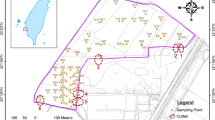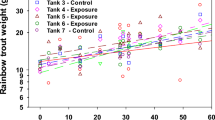Abstract
When the freshwater fish, topmouth gudgeon, was exposed to continuous flow water containing 20 ppb of CNP (2,4,6-trichlorophenyl-4′-nitrophenyl ether), CNP concentration in the fish body gradually increased and reached equilibrium after seven days. CNP concentration and bioconcentration ratio (partition coefficient between fish body and water) after 15 days were 25.3 ppm and 1109, respectively. When the fish was transferred into clean water, the CNP taken into the fish body was slowly excreted and decreased to 0.115 ppm after 30 days. In order to examine distribution and metabolism of CNP in the fish body, an exposure test to static water containing 20 and 100 ppb of14C-labeled CNP was conducted. The concentration of14C-CNP equivalent after seven days was decreased in the following order: kidney, viscera except kidney and liver, liver, head, muscle. More than 90% of the toluene-soluble fraction of the14C in each organ was the parent compound (CNP), and no significant decrease in the concentration of14C-CNP equivalent in each organ of the fish was found seven days after transfer into clean water. Consequently it appears that CNP is fairly persistent in the fish body.
Several metabolites in the toluene-soluble fraction of fish and water were detected by TLC. Among these metabolites, only amino-CNP andp-nitrophenol were indentified by GLC.
Similar content being viewed by others
References
Lee, A. H., P. Y. Lu, R. L. Metcalf, and E. L. Hsu: The environmental fate of three dichlorophenyl nitrophenyl ether herbicides in a rice paddy model ecosystem. J. Environ. Qual.5, 482 (1976).
Metcalf, R. L., and J. R. Sanborn: Pesticides and environmental quality in Illinois. Illinois Natural History Survey Bulletin31, Article 9, 381 (1975).
Nishiuchi, Y., and Y. Hashimoto: Toxicity of pesticide ingredients to some fresh water organisms. Botyu-Kagaku32, 5 (1967).
Toyama, T., and Y. Takazawa: Herbicide, MO® (p-nitrophenyl 2,4,6-trichlorophenyl ether). Noyaku Seisan Gijutsu No.23, 1 (1971).
Author information
Authors and Affiliations
Rights and permissions
About this article
Cite this article
Kanazawa, J., Tomizawa, C. Intake and excretion of 2,4,6-trichlorophenyl-4′-nitrophenyl ether by topmouth gudgeon,Pseudorasbora parva . Arch. Environ. Contam. Toxicol. 7, 397–407 (1978). https://doi.org/10.1007/BF02332067
Received:
Accepted:
Issue Date:
DOI: https://doi.org/10.1007/BF02332067




